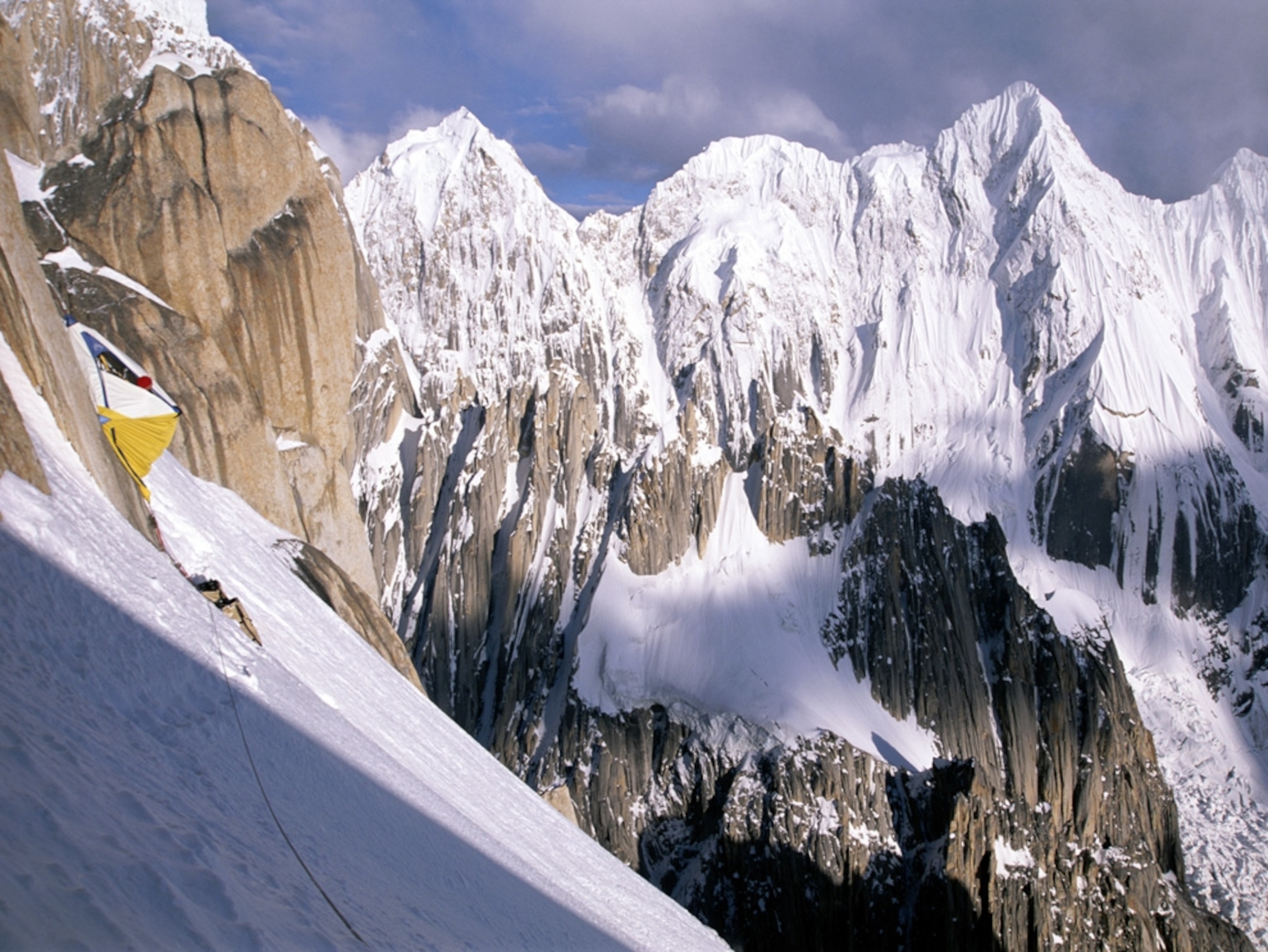
Photograph by Jimmy Chin
Action and Adventure Photography Quick Tips
Keep these tips from photographer Bill Hatcher in mind as you're taking action and adventure photos.
ByBill Hatcher
3 min read
- Though useful for holding big heavy lenses, and for long exposures, tripods usually slow the action photographer down. Think very carefully about your use of the tripod before you bring one. A monopod is a very lightweight alternative to a tripod for following action and shooting with a big lens.
- Remember to keep your cameras clean. During times of blowing dust or sand, avoid changing film—or, with digital cameras, changing lenses. Wait until the storm has passed or open the camera in a clean sand- and dust-free environment indoors.
- Don't always use the camera rectangle to frame your picture. Look for natural frames, such as an arch or the shaded walls of a canyon. A frame can be a dramatic device to enhance your subject.
- Always keep an eye on camera frame numbers and battery levels, and make sure your camera is set for rapid shooting. If you're just a few frames from the end of a roll of film, or from filling your digital memory card, change it out if you anticipate any action.
- Keep your flash close at hand. Just a light touch of electronic flash can add a sparkle to a person's eye or pump up color in a drab scene.
- Cameras and flashes have complex program modes, so always travel with a copy of the instruction manual. These technical manuals are usually in several languages—copy only one language to save weight and bulk.
- When shooting portraits, try backing up a little to include the environment around the person.
- After you have made a wide shot, move in closer to capture detail photos—these often contain their own stories.
- Try POV (point of view) shots, shooting from unusual angles or from the viewpoint of the participant you are photographing. POV angles are effective in bringing the viewer into the action of the scene.
- When you see a unique event unfold, don't waste time—make the best of the equipment you have in your hands, find the best position to compose the shot, and start shooting. Don't worry about wasting film or memory on your card.
- Always be on the lookout for humor. You might be surprised at how frequently it shows up, even in the most extreme environments.
- Carry a couple of one-gallon Ziploc bags. They are waterproof and dustproof and can be used to protect lenses and film. A bag can also be fashioned into a tent cover for your camera so you can shoot in the rain.
- In foreign countries, often the simple act of pointing to your camera and pointing to the subject is enough to communicate the fact that you'd like to photograph them. Always read up about native customs before traveling to a foreign culture. Always smile.
- When shooting adventure and action, know the abilities of the people you're photographing to avoid accidents. People will often exceed the limits of their ability for the camera.
- Must have gear for shooting in the sun on an open playing field are a hat, water, and an energy bar.
Related Topics
Go Further
Animals
- Soy, skim … spider. Are any of these technically milk?Soy, skim … spider. Are any of these technically milk?
- This pristine piece of the Amazon shows nature’s resilienceThis pristine piece of the Amazon shows nature’s resilience
- Octopuses have a lot of secrets. Can you guess 8 of them?
- Animals
- Feature
Octopuses have a lot of secrets. Can you guess 8 of them?
Environment
- This pristine piece of the Amazon shows nature’s resilienceThis pristine piece of the Amazon shows nature’s resilience
- Listen to 30 years of climate change transformed into haunting musicListen to 30 years of climate change transformed into haunting music
- This ancient society tried to stop El Niño—with child sacrificeThis ancient society tried to stop El Niño—with child sacrifice
- U.S. plans to clean its drinking water. What does that mean?U.S. plans to clean its drinking water. What does that mean?
History & Culture
- Gambling is everywhere now. When is that a problem?Gambling is everywhere now. When is that a problem?
- Beauty is pain—at least it was in 17th-century SpainBeauty is pain—at least it was in 17th-century Spain
- The real spies who inspired ‘The Ministry of Ungentlemanly Warfare’The real spies who inspired ‘The Ministry of Ungentlemanly Warfare’
- Heard of Zoroastrianism? The religion still has fervent followersHeard of Zoroastrianism? The religion still has fervent followers
- Strange clues in a Maya temple reveal a fiery political dramaStrange clues in a Maya temple reveal a fiery political drama
Science
- NASA has a plan to clean up space junk—but is going green enough?NASA has a plan to clean up space junk—but is going green enough?
- Soy, skim … spider. Are any of these technically milk?Soy, skim … spider. Are any of these technically milk?
- Can aspirin help protect against colorectal cancers?Can aspirin help protect against colorectal cancers?
- The unexpected health benefits of Ozempic and MounjaroThe unexpected health benefits of Ozempic and Mounjaro
- Do you have an inner monologue? Here’s what it reveals about you.Do you have an inner monologue? Here’s what it reveals about you.
Travel
- Follow in the footsteps of Robin Hood in Sherwood ForestFollow in the footsteps of Robin Hood in Sherwood Forest
- This chef is taking Indian cuisine in a bold new directionThis chef is taking Indian cuisine in a bold new direction
- On the path of Latin America's greatest wildlife migrationOn the path of Latin America's greatest wildlife migration
- Everything you need to know about Everglades National ParkEverything you need to know about Everglades National Park




